The Hidden Carbon Cost of Forest Fire Management: Quantifying Greenhouse Gas Emissions from Both Vegetation Burning and Social Rescue Activities in Yajiang County, China
Abstract
1. Introduction
2. Materials and Methods
2.1. Research Overview
2.1.1. Fire-Burned Area
2.1.2. Social Rescue Activities
2.2. Research Methods
2.2.1. GHG Emissions from Vegetation Burning
- (1)
- Acquisition and Processing of Remote Sensing Images
- (2)
- Classification of the Burn Severity and the Land Cover in the Overfire Area
- (3)
- AGB of Different Vegetation Types
- (4)
- Calculation of Combustible Load and Carbon Emission
2.2.2. GHG Emissions from Social Rescue Activities
- (1)
- Disaster Response Logistics and Method Application
- (2)
- Estimation of Transportation Distance (Mileage)
- (3)
- Fuel Ratio and Energy Consumption Estimation for Transportation Vehicles
- (4)
- Determination of Fuel Emission Factors
- (5)
- GHG Emissions from the Fire Extinguishing Process and the Electricity Generation Process
2.2.3. Data Limitations and Assumptions
3. Results and Suggestions
3.1. Results
3.1.1. Emissions from Vegetation Burning
3.1.2. Emissions from Social Rescue Activities
3.1.3. Sources of Error and Uncertainty in GHG Emission Estimates
3.2. Suggestions
3.2.1. Optimization of Forest Management
- (1)
- Mechanical Thinning
- (2)
- Constructing Access Roads
- (3)
- Green Fire Barriers
3.2.2. Optimization of Fire Rescue Management
- (1)
- Increase Financial Support
- (2)
- Strategic Placement of Water Sources
- (3)
- Road Development and Infrastructure Resilience
4. Conclusions and Perspectives
Supplementary Materials
Author Contributions
Funding
Data Availability Statement
Conflicts of Interest
References
- Ayugi, B.O.; Chung, E.-S.; Zhu, H.; Ogega, O.M.; Babousmail, H.; Ongoma, V. Projected changes in extreme climate events over Africa under 1.5 °C, 2.0 °C and 3.0 °C global warming levels based on CMIP6 projections. Atmos. Res. 2023, 292, 106872. [Google Scholar] [CrossRef]
- Weckenborg, C.; Graupner, Y.; Spengler, T.S. Prospective assessment of transformation pathways toward low-carbon steelmaking: Evaluating economic and climate impacts in Germany. Resour. Conserv. Recycl. 2024, 203, 107434. [Google Scholar] [CrossRef]
- van der Werf, G.R.; Randerson, J.T.; Giglio, L.; Collatz, G.J.; Mu, M.; Kasibhatla, P.S.; Morton, D.C.; DeFries, R.S.; Jin, Y.; van Leeuwen, T.T. Global fire emissions and the contribution of deforestation, savanna, forest, agricultural, and peat fires (1997–2009). Atmos. Chem. Phys. 2010, 10, 11707–11735. [Google Scholar] [CrossRef]
- Yue, X.-L.; Gao, Q.-X. Contributions of natural systems and human activity to greenhouse gas emissions. Adv. Clim. Chang. Res. 2018, 9, 243–252. [Google Scholar] [CrossRef]
- Randerson, J.T.; Chen, Y.; van der Werf, G.R.; Rogers, B.M.; Morton, D.C. Global burned area and biomass burning emissions from small fires. J. Geophys. Res. Biogeosci. 2012, 117, G04012. [Google Scholar] [CrossRef]
- Alcasena, F.; Rodrigues, M.; Gelabert, P.; Ager, A.; Salis, M.; Ameztegui, A.; Cervera, T.; Vega-García, C. Fostering Carbon Credits to Finance Wildfire Risk Reduction Forest Management in Mediterranean Landscapes. Land 2021, 10, 1104. [Google Scholar] [CrossRef]
- Penman, J.; Gytarsky, M.; Hiraishi, T.; Krug, T.; Kruger, D.; Pipatti, R.; Buendia, L.; Miwa, K.; Ngara, T.; Tanabe, K. Definitions and Methodological Options to Inventory Emissions from Direct Human-Induced Degradation of Forests and Devegetation of Other Vegetation Types; Institute for Global Environmental Strategies (IGES) for the IPCC: Hayama, Japan, 2003; p. 32. [Google Scholar]
- Martins, V.; Miranda, A.I.; Carvalho, A.; Schaap, M.; Borrego, C.; Sa, E. Impact of forest fires on particulate matter and ozone levels during the 2003, 2004 and 2005 fire seasons in Portugal. Sci. Total Environ. 2012, 414, 53–62. [Google Scholar] [CrossRef] [PubMed]
- Rosa, I.M.D.; Pereira, J.M.C.; Tarantola, S. Atmospheric emissions from vegetation fires in Portugal (1990–2008): Estimates, uncertainty analysis, and sensitivity analysis. Atmos. Chem. Phys. 2011, 11, 2625–2640. [Google Scholar] [CrossRef]
- Fernandes, A.P.; Lopes, D.; Sorte, S.; Monteiro, A.; Gama, C.; Reis, J.; Menezes, I.; Osswald, T.; Borrego, C.; Almeida, M.; et al. Smoke emissions from the extreme wildfire events in central Portugal in October 2017. Int. J. Wildland Fire 2022, 31, 989–1001. [Google Scholar] [CrossRef]
- Goparaju, L.; Pillutla, R.C.P.; Venkata, S.B.K. Assessment of forest fire emissions in Uttarakhand State, India, using Open Geospatial data and Google Earth Engine. Environ. Sci Pollut. Res. Int. 2023, 30, 100873–100891. [Google Scholar] [CrossRef]
- Volkova, L.; Roxburgh, S.H.; Surawski, N.C.; Meyer, C.P.; Weston, C.J. Improving reporting of national greenhouse gas emissions from forest fires for emission reduction benefits: An example from Australia. Environ. Sci. Policy 2019, 94, 49–62. [Google Scholar] [CrossRef]
- Monteiro, A.; Corti, P.; San Miguel-Ayanz, J.; Miranda, A.I.; Borrego, C. The EFFIS forest fire atmospheric emission model: Application to a major fire event in Portugal. Atmos. Environ. 2014, 84, 355–362. [Google Scholar] [CrossRef]
- Pimont, F.; Linn, R.R.; Dupuy, J.-L.; Morvan, D. Effects of vegetation description parameters on forest fire behavior with FIRETEC. For. Ecol. Manag. 2006, 234, S120. [Google Scholar] [CrossRef]
- Dasdemir, I.; Aydin, F.; Ertugrul, M. Factors Affecting the Behavior of Large Forest Fires in Turkey. Environ. Manag. 2021, 67, 162–175. [Google Scholar] [CrossRef]
- Zeng, S.-P.; Liu, F.-L.; Zhao, M.-F.; Ai, Y.; Chen, X.-W. Age-and organ-related variances in fire resistance traits of typical tree species in subtropical China. Ying Yong Sheng Tai Xue Bao J. Appl. Ecol. 2020, 31, 1063–1072. [Google Scholar] [CrossRef]
- Stevens, J.T.; Kling, M.M.; Schwilk, D.W.; Varner, J.M.; Kane, J.M.; Gillespie, T. Biogeography of fire regimes in western U.S. conifer forests: A trait-based approach. Glob. Ecol. Biogeogr. 2020, 29, 944–955. [Google Scholar] [CrossRef]
- Seiler, W.; Crutzen, P.J. Estimates of gross and net fluxes of carbon between the biosphere and the atmosphere from biomass burning. Clim. Chang. 1980, 2, 207–247. [Google Scholar] [CrossRef]
- Navarro, G.; Caballero, I.; Silva, G.; Parra, P.-C.; Vázquez, Á.; Caldeira, R. Evaluation of forest fire on Madeira Island using Sentinel-2A MSI imagery. Int. J. Appl. Earth Obs. Geoinf. 2017, 58, 97–106. [Google Scholar] [CrossRef]
- Veraverbeke, S.; Verstraeten, W.W.; Lhermitte, S.; Goossens, R. Evaluating Landsat Thematic Mapper spectral indices for estimating burn severity of the 2007 Peloponnese wildfires in Greece. Int. J. Wildland Fire 2010, 19, 558–569. [Google Scholar] [CrossRef]
- Ma, S.; Qiao, Y.-P.; Wang, L.-J.; Zhang, J.-C. Terrain gradient variations in ecosystem services of different vegetation types in mountainous regions: Vegetation resource conservation and sustainable development. For. Ecol. Manag. 2021, 482, 118856. [Google Scholar] [CrossRef]
- Fan, D.; Wang, M.; Liang, T.; He, H.; Zeng, Y.; Fu, B. Estimation and trend analysis of carbon emissions from forest fires in mainland China from 2011 to 2021. Ecol. Inform. 2024, 81, 102572. [Google Scholar] [CrossRef]
- Xi, Y. Remote Sensing Image Based Forest Fire Carbon in Daxingan Mountains in Recent Ten Years Release Estimate. Master’s Thesis, Northeast Forestry University, Harbin, China, 2020. [Google Scholar] [CrossRef]
- Zhang, H.; Song, T.; Wang, K.; Yang, H.; Yue, Y.; Zeng, Z.; Peng, W.; Zeng, F. Influences of stand characteristics and environmental factors on forest biomass and root–shoot allocation in southwest China. Ecol. Eng. 2016, 91, 7–15. [Google Scholar] [CrossRef]
- Liu, L.; Yang, H.; Xu, Y.; Guo, Y.; Ni, J. Forest Biomass and Net Primary Productivity in Southwestern China: A Meta-Analysis Focusing on Environmental Driving Factors. Forests 2016, 7, 173. [Google Scholar] [CrossRef]
- Liu, M.; Li, D.; Hu, J.; Liu, D.; Ma, Z.; Cheng, X.; Zhao, C.; Liu, Q. Altitudinal pattern of shrub biomass allocation in Southwest China. PLoS ONE 2020, 15, e0240861. [Google Scholar] [CrossRef] [PubMed]
- Zhou, X.; Hu, C.; Wang, Z. Distribution of biomass and carbon content in estimation of carbon density for typical forests. Glob. Ecol. Conserv. 2023, 48, e02707. [Google Scholar] [CrossRef]
- Sun, Y.; Zhang, Q.; Li, K.; Huo, Y.; Zhang, Y. Trace gas emissions from laboratory combustion of leaves typically consumed in forest fires in Southwest China. Sci. Total Environ. 2022, 846, 157282. [Google Scholar] [CrossRef]
- Jiao, J.; Huang, Y.; Liao, C.; Zhao, D. Sustainable development path research on urban transportation based on synergistic and cost-effective analysis: A case of Guangzhou. Sustain. Cities Soc. 2021, 71, 102950. [Google Scholar] [CrossRef]
- Zhang, L.; Long, R.; Chen, H.; Geng, J. A review of China’s road traffic carbon emissions. J. Clean. Prod. 2019, 207, 569–581. [Google Scholar] [CrossRef]
- Ministry of Ecology and Environment of the People’s Republic of China. China Mobile Source Environmental Management Annual Report; Ministry of Ecology and Environment of the People’s Republic of China: Beijing, China, 2021. [Google Scholar]
- Standardization Administration of the People’s Republic of China. General Rules for Calculation of the Comprehensive; Standardization Administration of the People’s Republic of China: Beijing, China, 2020. [Google Scholar]
- Clinton, N.E.; Gong, P.; Scott, K. Quantification of pollutants emitted from very large wildland fires in Southern California, USA. Atmos. Environ. 2006, 40, 3686–3695. [Google Scholar] [CrossRef]
- French, N.H.; De Groot, W.J.; Jenkins, L.K.; Rogers, B.M.; Alvarado, E.; Amiro, B.; De Jong, B.; Goetz, S.; Hoy, E.; Hyer, E. Model comparisons for estimating carbon emissions from North American wildland fire. J. Geophys. Res. Biogeosci. 2011, 116, G00K05. [Google Scholar] [CrossRef]
- Hodnebrog, Ø.; Solberg, S.; Stordal, F.; Svendby, T.M.; Simpson, D.; Gauss, M.; Hilboll, A.; Pfister, G.G.; Turquety, S.; Richter, A.; et al. Impact of forest fires, biogenic emissions and high temperatures on the elevated Eastern Mediterranean ozone levels during the hot summer of 2007. Atmos. Chem. Phys. 2012, 12, 8727–8750. [Google Scholar] [CrossRef]
- Castellanos, P.; Boersma, K.F.; van der Werf, G.R. Satellite observations indicate substantial spatiotemporal variability in biomass burning NOx emission factors for South America. Atmos. Chem. Phys. 2014, 14, 3929–3943. [Google Scholar] [CrossRef]
- Schreier, S.F.; Richter, A.; Schepaschenko, D.; Shvidenko, A.; Hilboll, A.; Burrows, J.P. Differences in satellite-derived NOx emission factors between Eurasian and North American boreal forest fires. Atmos. Environ. 2015, 121, 55–65. [Google Scholar] [CrossRef]
- Stephens, S.L.; Foster, D.E.; Battles, J.J.; Bernal, A.A.; Collins, B.M.; Hedges, R.; Moghaddas, J.J.; Roughton, A.T.; York, R.A. Forest restoration and fuels reduction work: Different pathways for achieving success in the Sierra Nevada. Ecol. Appl. 2024, 34, e2932. [Google Scholar] [CrossRef] [PubMed]
- Guo, L.; Wu, Z.; Li, S. The relative impacts of vegetation, topography and weather on landscape patterns of burn severity in subtropical forests of southern China. J. Environ. Manag. 2024, 351, 119733. [Google Scholar] [CrossRef] [PubMed]
- Wang, H.-H.; Finney, M.A.; Song, Z.-L.; Wang, Z.-S.; Li, X.-C. Ecological techniques for wildfire mitigation: Two distinct fuelbreak approaches and their fusion. For. Ecol. Manag. 2021, 495, 119376. [Google Scholar] [CrossRef]
- Alam, M.A.; Wyse, S.V.; Buckley, H.L.; Perry, G.L.; Sullivan, J.J.; Mason, N.W.; Buxton, R.; Richardson, S.J.; Curran, T.J. Shoot flammability is decoupled from leaf flammability, but controlled by leaf functional traits. J. Ecol. 2020, 108, 641–653. [Google Scholar] [CrossRef]
- Wang, H.; Li, D.; Hong, M.; Dou, J. Syntheses, structural characterization and in vitro cytotoxic activity of triorganotin(IV) complexes based on 1,7-dihydroxycarbonyl-1,7-dicarba-closo-dodecaborane ligand. J. Organomet. Chem. 2013, 740, 1–9. [Google Scholar] [CrossRef]
- Wang, H.-H. Scientific Basis and Prospects of Biological Fire-prevention-belt Technique. Lin Ye Ke Xue Yan Jiu 2015, 28, 731. [Google Scholar]
- Mishra, M.; Guria, R.; Baraj, B.; Nanda, A.P.; Santos, C.A.G.; da Silva, R.M.; Laksono, F.A.T. Spatial analysis and machine learning prediction of forest fire susceptibility: A comprehensive approach for effective management and mitigation. Sci. Total Environ. 2024, 926, 171713. [Google Scholar] [CrossRef]
- Moore, D.; Kearney, M.R.; Paltridge, R.; McAlpin, S.; Stow, A. Is fire a threatening process for Liopholis kintorei, a nationally listed threatened skink? Wildl. Res. 2015, 42, 207–216. [Google Scholar] [CrossRef]
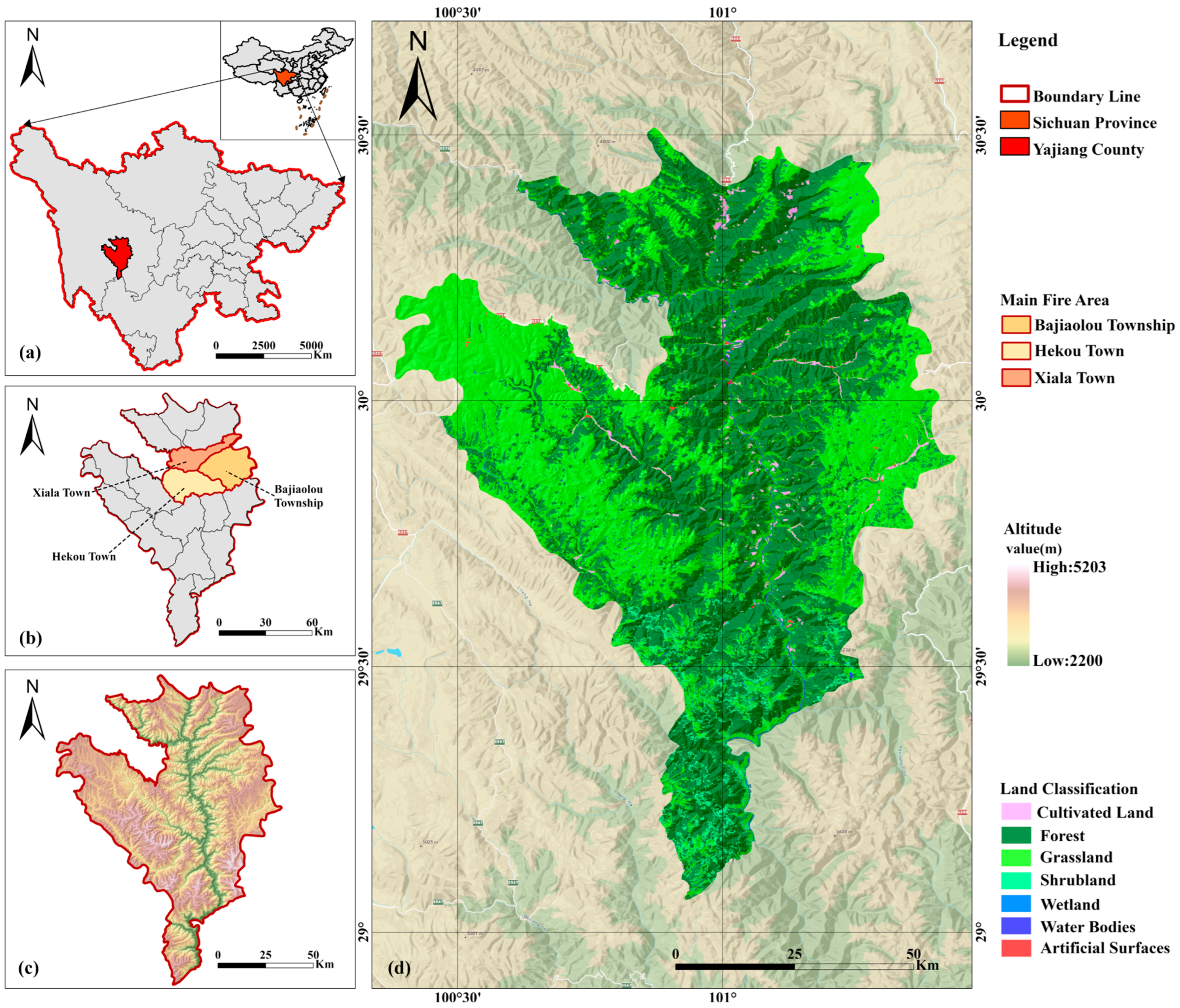
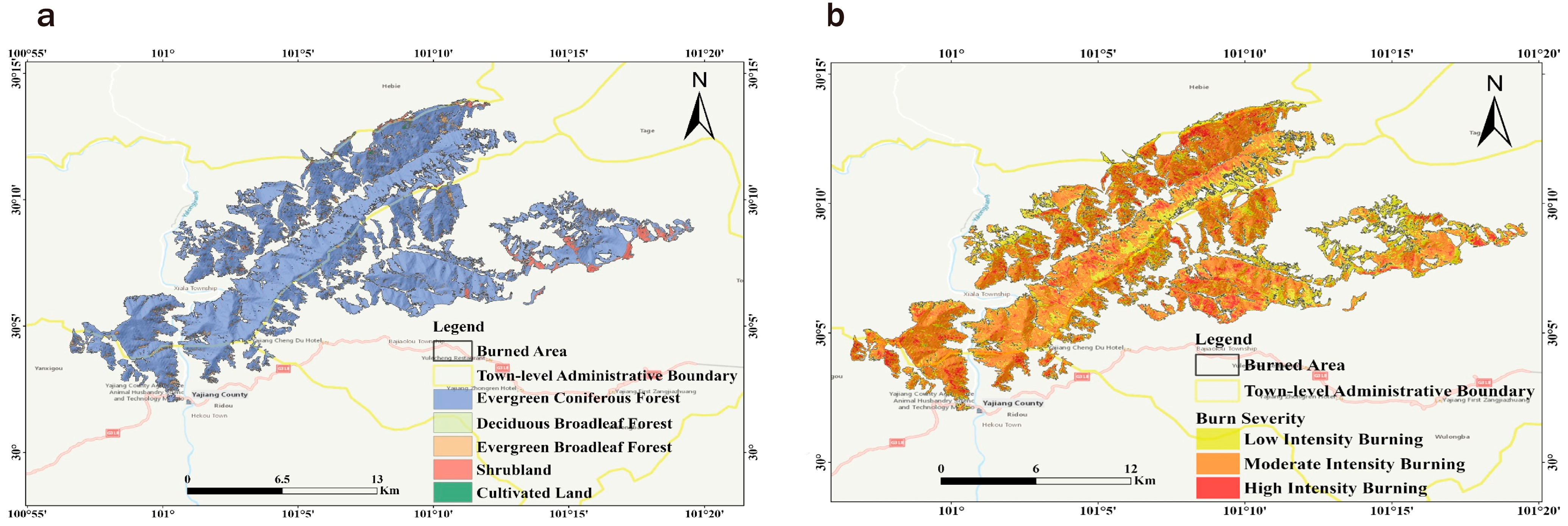
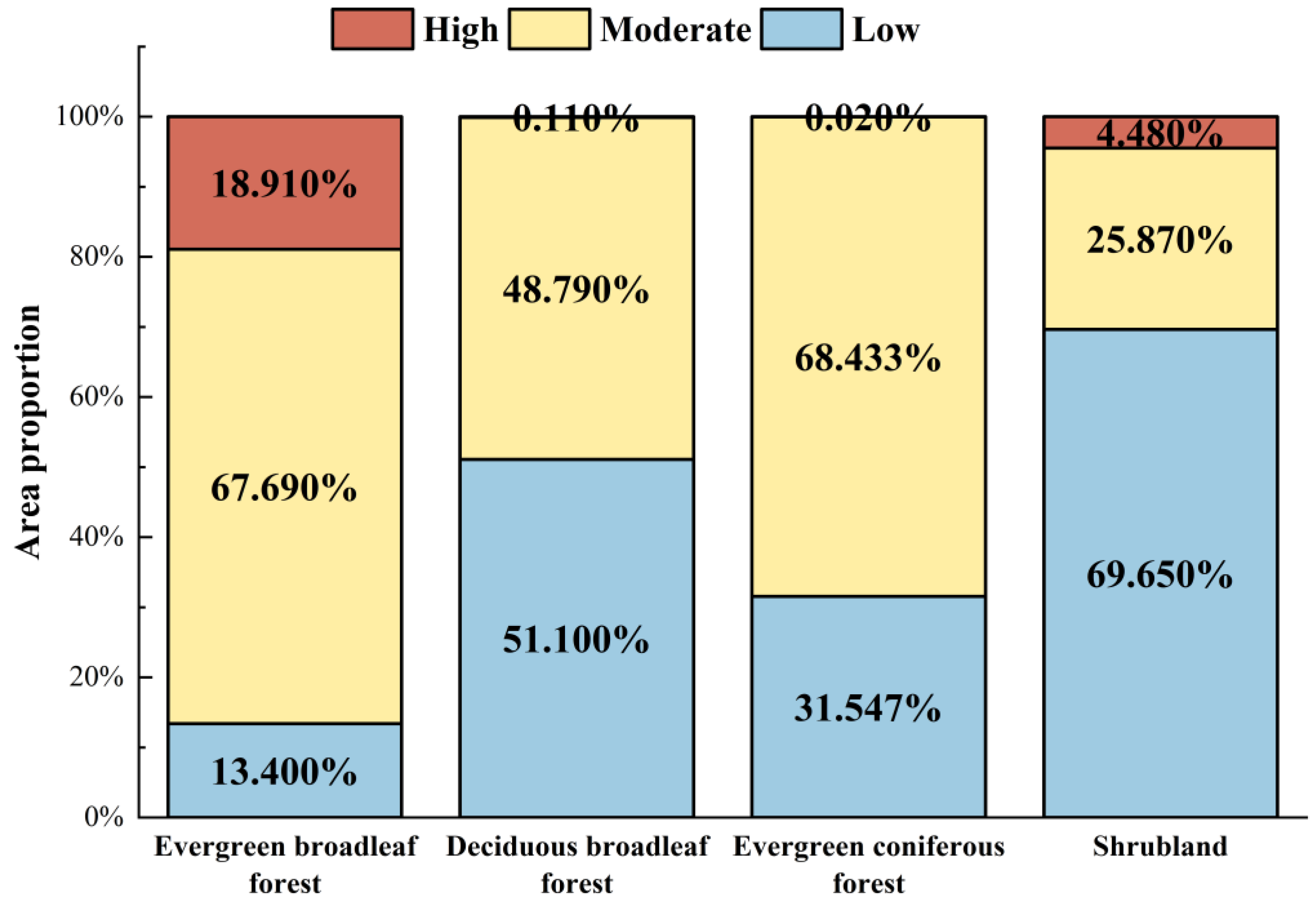

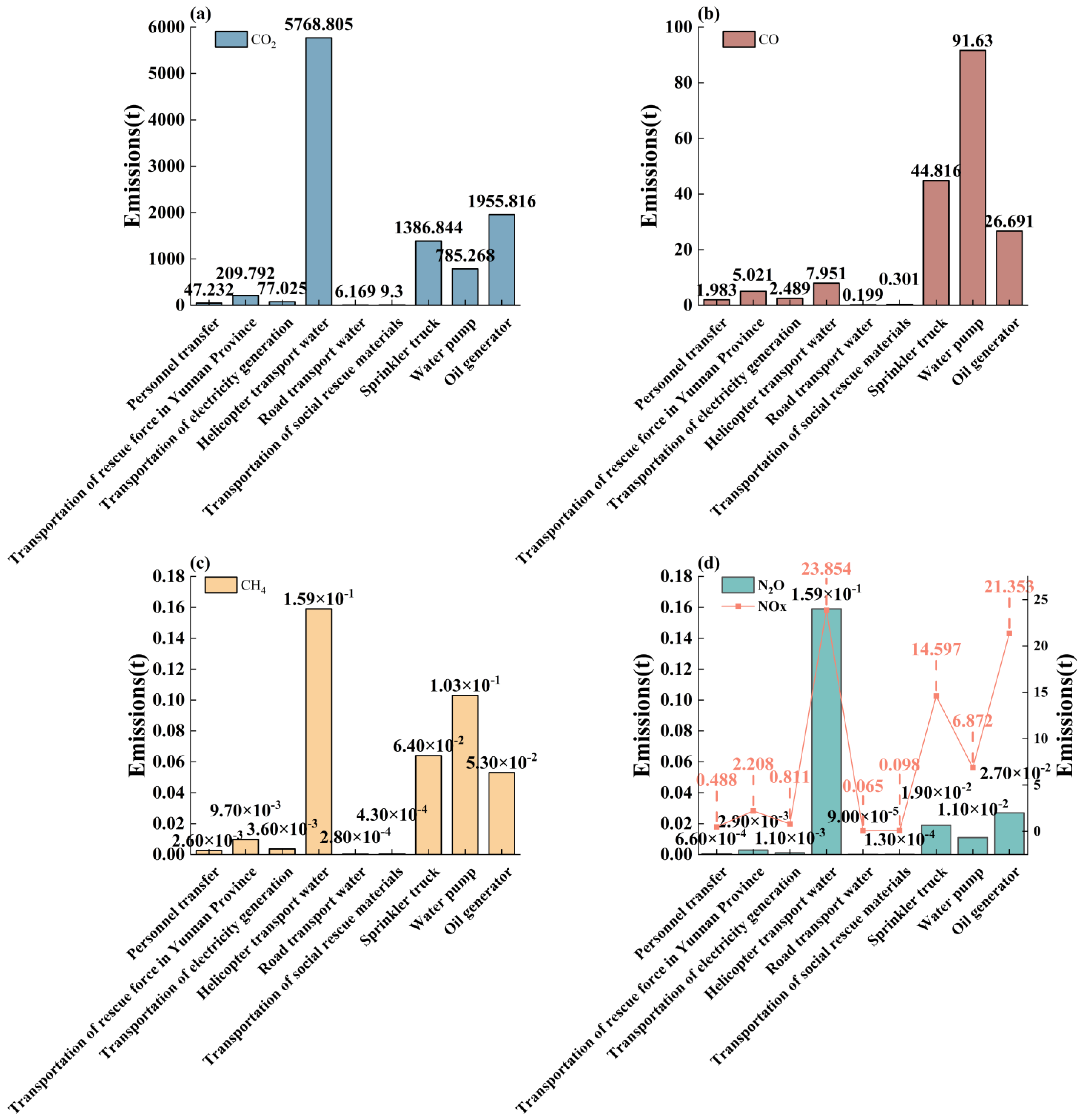
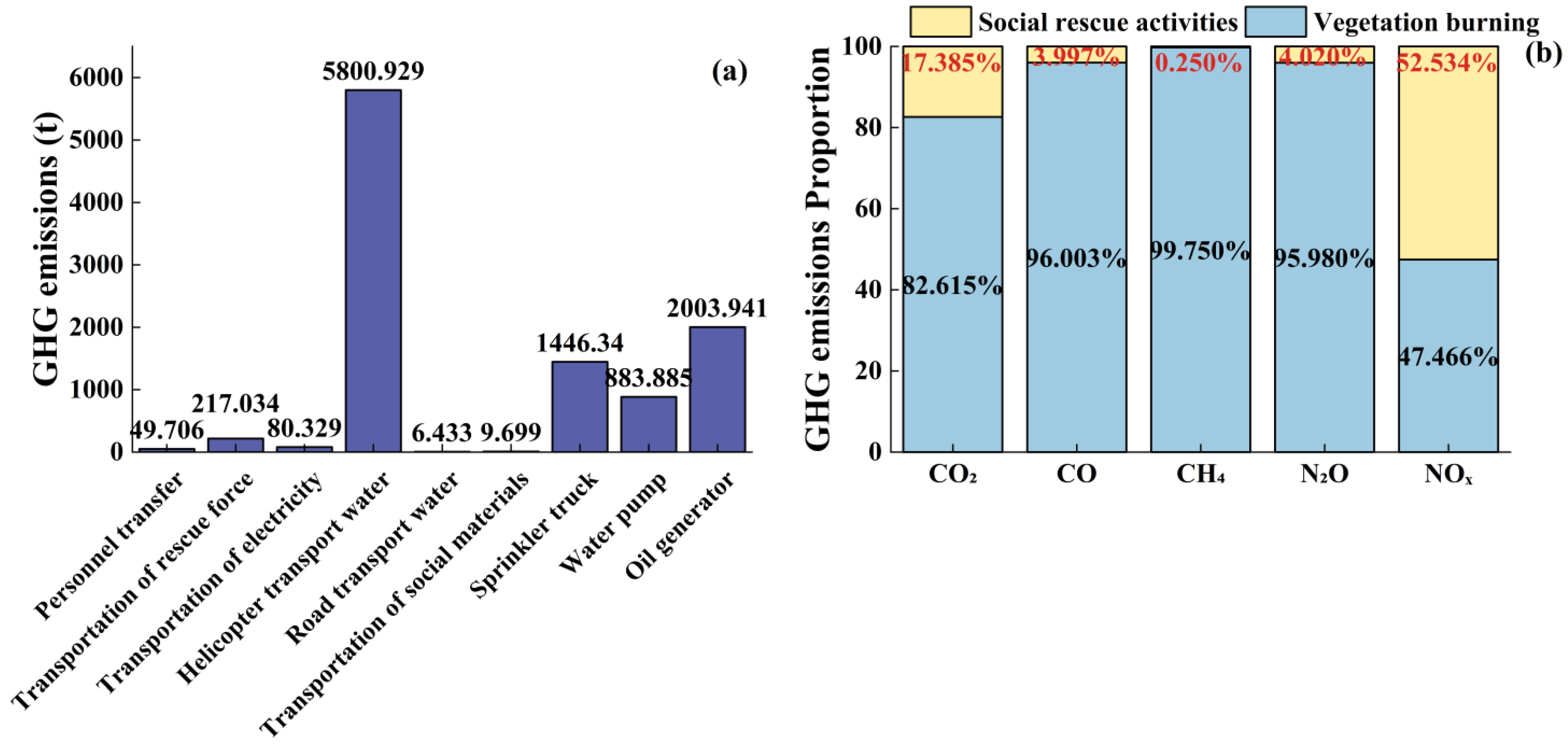
| Vegetation Type | TB (t/hm2) | Carbon Content (%) |
|---|---|---|
| Evergreen broadleaf forest | 230.54 | 0.4664 |
| Evergreen coniferous forest | 243.4 | 0.5179 |
| Deciduous broadleaf forest | 212.2 | 0.4664 |
| Shrubland | 25.9 | 0.4546 |
| Gas Type | CO2 | CO | CH4 | N2O | NOx |
|---|---|---|---|---|---|
| Emission factor | 1754.27 | 156.71 | 5.68 | 0.19 | 2.29 |
| Transport Type | Calculation Content | Calculation Method | Calculation Formula |
|---|---|---|---|
| Highway passenger transport | Relocation of residents | Turnover method | |
| Rescue personnel transportation | |||
| Road freight | Firefighting water transportation | ||
| Social relief material transportation | |||
| Air cargo | Helicopter water transportation | ||
| Yunnan rescue force transportation | 100 km energy consumption method | ||
| Electricity generation vehicles | |||
| Department | Energy Types | CO2 | CO | CH4 | N2O | NOx |
|---|---|---|---|---|---|---|
| Highway | Gasoline | 68.560 | 8.000 | 0.009 | 0.001 | 0.600 |
| Diesel oil | 73.275 | 1.000 | 0.002 | 0.001 | 0.800 | |
| Aviation | Kerosene | 72.550 | 0.100 | 0.002 | 0.002 | 0.300 |
| Process | Type | Emissions (t) | ||||
|---|---|---|---|---|---|---|
| CO2 | CO | CH4 | N2O | NOx | ||
| Vegetation burning process | Evergreen broadleaf forest | 1173.069 | 104.791 | 3.798 | 0.127 | 1.531 |
| Evergreen coniferous forest | 46,620.631 | 4164.649 | 150.949 | 5.049 | 60.858 | |
| Deciduous broadleaf forest | 139.132 | 12.429 | 0.450 | 0.0151 | 0.182 | |
| Shrubland | 757.443 | 67.663 | 2.452 | 0.082 | 0.989 | |
| Transportation process | Personnel transfer | 47.232 | 1.983 | 0.0026 | 0.00066 | 0.488 |
| Transportation of rescue force in Yunnan Province | 209.792 | 5.021 | 0.0097 | 0.0029 | 2.208 | |
| Transportation of electricity generation | 77.025 | 2.489 | 0.0036 | 0.0011 | 0.811 | |
| Helicopter transport water | 5768.805 | 7.951 | 0.159 | 0.159 | 23.854 | |
| Road transport water | 6.169 | 0.199 | 0.00028 | 0.00009 | 0.065 | |
| Transportation of social rescue materials | 9.300 | 0.301 | 0.00043 | 0.00013 | 0.098 | |
| Fire extinguishing and electricity generation process | Sprinkler truck | 1386.844 | 44.816 | 0.064 | 0.019 | 14.597 |
| Water pump | 785.268 | 91.630 | 0.103 | 0.011 | 6.872 | |
| Oil generator | 1955.816 | 26.691 | 0.053 | 0.027 | 21.353 | |
| Total emissions | 58,936.526 | 4530.614 | 158.046 | 5.495 | 133.906 | |
Disclaimer/Publisher’s Note: The statements, opinions and data contained in all publications are solely those of the individual author(s) and contributor(s) and not of MDPI and/or the editor(s). MDPI and/or the editor(s) disclaim responsibility for any injury to people or property resulting from any ideas, methods, instructions or products referred to in the content. |
© 2025 by the authors. Licensee MDPI, Basel, Switzerland. This article is an open access article distributed under the terms and conditions of the Creative Commons Attribution (CC BY) license (https://creativecommons.org/licenses/by/4.0/).
Share and Cite
Ye, Z.; Wang, Y.; Zhao, X.; Wang, Y.; Liao, J.; Min, J.; Gong, X.; Wang, D.; Gong, Z. The Hidden Carbon Cost of Forest Fire Management: Quantifying Greenhouse Gas Emissions from Both Vegetation Burning and Social Rescue Activities in Yajiang County, China. Forests 2025, 16, 803. https://doi.org/10.3390/f16050803
Ye Z, Wang Y, Zhao X, Wang Y, Liao J, Min J, Gong X, Wang D, Gong Z. The Hidden Carbon Cost of Forest Fire Management: Quantifying Greenhouse Gas Emissions from Both Vegetation Burning and Social Rescue Activities in Yajiang County, China. Forests. 2025; 16(5):803. https://doi.org/10.3390/f16050803
Chicago/Turabian StyleYe, Zilin, Yanjun Wang, Xijin Zhao, Yugang Wang, Jing Liao, Jian Min, Xun Gong, Dongmei Wang, and Zhengjun Gong. 2025. "The Hidden Carbon Cost of Forest Fire Management: Quantifying Greenhouse Gas Emissions from Both Vegetation Burning and Social Rescue Activities in Yajiang County, China" Forests 16, no. 5: 803. https://doi.org/10.3390/f16050803
APA StyleYe, Z., Wang, Y., Zhao, X., Wang, Y., Liao, J., Min, J., Gong, X., Wang, D., & Gong, Z. (2025). The Hidden Carbon Cost of Forest Fire Management: Quantifying Greenhouse Gas Emissions from Both Vegetation Burning and Social Rescue Activities in Yajiang County, China. Forests, 16(5), 803. https://doi.org/10.3390/f16050803






